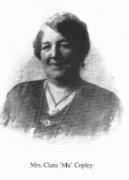|
|
||||||||||||||||||||||||
 |
Featured person
Recently added |
Henry Barcroft (1839 - 1905): |
||||||||||||||||||||||
Barcroft was born into a Quaker family in Lisburn active in the linen business. His sister Sarah became a noted Quaker minister who travelled in France and England, promoting the Society. He married in 1867, a member of the Richardson family who carried on linen production in Bessbrook, County Armagh, and was soon company secretary to the Richardsons' business in Bessbrook.
The Richardsons were also Quakers, who developed Bessbrook into a model village: no public houses, no pawnbrokers and therefore no police, was a guiding principle. Barcroft patented in 1869 a model jacquard power-loom (used for weaving complex patterns and based on a punched card system) which came to be known as the Bessbrook Machine. This machine was very successful and its produce was even exhibited to acclaim at the United States International Exhibition, Philadelphia in 1876. The produce in question was a tapestry depicting depicting the concluding of what was called the Great Treaty of 1682, between the early Quaker William Penn, son of an English Vice-Admiral and at twenty, a convert to Quakerism, and the Leni Lenape (Delaware) chiefs at the village of Shackamaxon (a notable event in American history also commemorated in a marble frieze in the United States Capitol building).
In May 1884, the Bessbrook and Newry Tramway Company came into being with Barcroft as a director. Its purpose was to transport goods, but it also operated as a public tramway, for the first time on 1st October 1885. It was Barcroft's innovative proposal to operate the tramway by hydro-electric power. He also developed a "flangeless" system which meant that the wagons could operate either on rails or on open road. His ingenious arrangement was to have a double track, which acted as the flange for the wheels. This enabled economical and efficient operation; the tramway operated until 1948. By 4th June 1900, Barcroft was chairman of the Bessbrook and Newry Tramway Company, which on that date approved a multi-ticket purchase facility, whereby the purchase of 50 tickets in one block entitled the buyer to a 25% reduction. He also patented a propeller for shallow-draft vessels operating on the Newry canal.
Barcroft was also known for philanthropic and charitable works and enabled the foundation of one of the first Carnegie Libraries in Ireland. As well as being Managing Director of Bessbrook Spinning Mills and a director of the Dundalk and Newry Packet Company, he also rose to be High Sheriff and Deputy Lieutenant of County Armagh.He died in Dublin after a period of poor health. One of his sons was Sir Joseph Barcroft, the noted physiologist. A grandson, also Henry Barcroft, was Dunville Professor of Physiology at Queen's University, Belfast (1935).
| Born: | 6 June 1839 |
| Died: | 18 November 1905 |
| Richard Froggatt |
| Acknowledgements: Wesley McCann |


Home | Our Policies | Plaques | Browse | Search | Sponsors | Links | Help | Contact
Privacy & Disclaimer | Cookie Policy | Site Map | Website Design By K-Point
© 2024 Ulster History Circle









